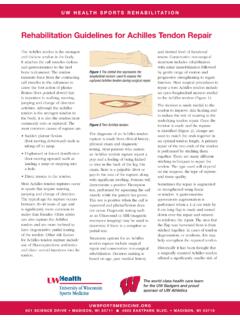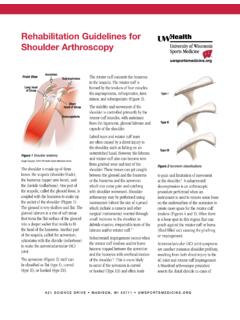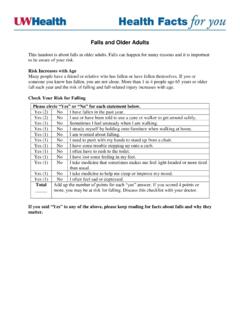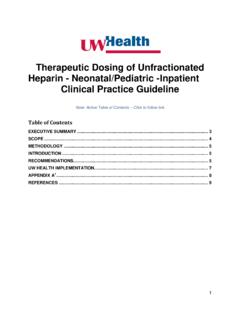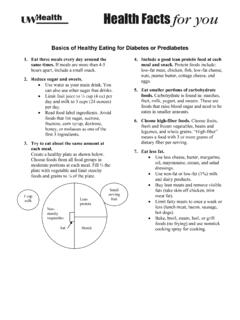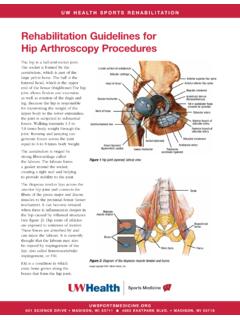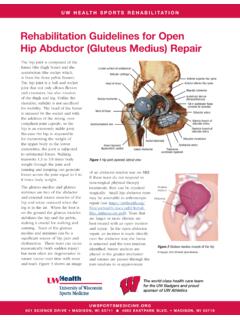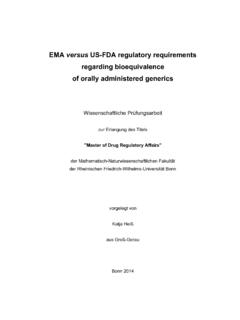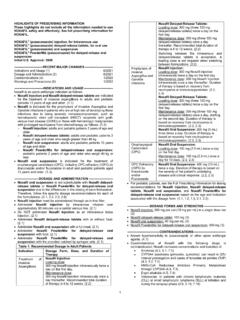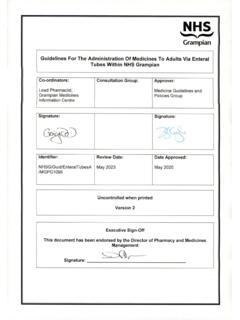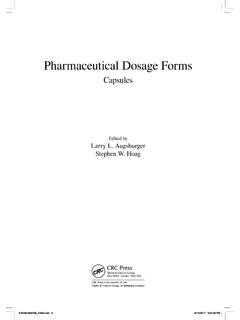Transcription of Electrolytes: Enteral and Intravenous – Adult – Inpatient ...
1 1 Electrolytes: Enteral and Intravenous Adult Inpatient Clinical Practice Guideline Note: Active Table of Contents Click each header below to jump to the section of interest Table of Contents INTRODUCTION .. 6 DEFINITIONS .. 6 RECOMMENDATIONS .. 7 1. POTASSIUM (K+) .. 72. PHOSPHATE (PO43-) .. 93. MAGNESIUM (MG2+) .. 104. CALCIUM (CA2+) .. 125. SLIDING SCALE ELECTROLYTES .. 14 METHODOLOGY .. 15 COLLATERAL TOOLS & RESOURCES .. 17 Copyright 2017 University of Wisconsin Hospitals and Clinics AuthorityContact: Lee Vermeulen, Last Revised: Content Expert: Name: Philip Trapskin, PharmD, BCPS Department of Pharmacy Phone Number: (608) 263- 1328 Email Address: Contact for Changes: Name: Philip Trapskin, PharmD, BCPS Department of Pharmacy Phone Number: (608) 263- 1328 Email Address: Guideline Authors: Emily Jackson, PharmD Sara Shull, PharmD, BCPS Joshua Vanderloo, PharmD, BCPS Original authors: Lindsey Goldsmith, PharmD.
2 Gordon Sacks, PharmD Reviewers: Pierre Kory, MD Critical Care Kenneth Kudsk, MD General Surgery Edward Lalik, MD Hospitalist Joshua Medow, MD Neurological Surgery Anne O Connor, MD Cardiovascular Medicine David Yang, MD Medical Director of UW Health Clinical Laboratories Theodore Berei, PharmD, BCPS Cardiovascular Medicine Caitlin Curtis, PharmD, BCNSP Nutrition Support Jeff Fish, PharmD, BCPS Critical Care Marie Pietruszka, PharmD, BCPS General Medicine Committee Approvals: Pharmacy and Therapeutics Committee December 2017 Copyright 2017 University of Wisconsin Hospitals and Clinics AuthorityContact: Lee Vermeulen, Last Revised: Table 1.
3 UW Health Guidelines for the Use of Oral, Enteral , and Intravenous Electrolytes in Adults1-34 Electrolyte Concentration Oral Gastric (NG/OG/PEG) For patients with Enteral access in small bowel, IV preferred due to adverse GI effects Standard Adult IV dose High-riskA Adult IV dose Notes Potassium Normal reference: mmol/L mmol/L 20 mEq potassium chloride caps/tabs/powder 20 mEq potassium chloride powder packets (dilute in ~100 mL per packet, see note 3) Use oral/ Enteral supplementation 20 mEq (see note 4) 1. If CrCl < 30 mL/min, reduce dose by 50% 2. For oral doses >20 mEq, divide into increments of 20 mEq given every 2 hours 3. If patient is fluid restricted, dilute oral powder in 50 mL 4.
4 Intravenous infusion rate: Peripheral line: max 10 mEq/hour Central line: max 20 mEq/hour mmol/L 40 mEq potassium chloride caps/tabs/powder (see note 2) 40 mEq potassium chloride powder packets (dilute in ~100 mL per packet, see note 3) Consider oral/ Enteral repletion; 40 mEq (see note 4) 40 mEq (see note 4) mmol/L If asymptomatic: may consider combination of Enteral and IV repletion with 20 mEq oral potassium chloride caps/tabs/powder and 40 mEq IV (see note 4) If symptomatic: IV repletion recommended (see IV dose columns) 60 mEq (see note 4) 60 mEq (see note 4) < mmol/L IV repletion recommended (see IV dose columns) 80 mEq (see note 4) 80 mEq (see note 4) Magnesium Normal reference.
5 Mg/dL mg/dL Consider no replacement, except in patients admitted on cardiac units, who have had recent cardiac surgery, or who have cardiac disorders, including arrhythmias, prolonged QTc, and digitalis toxicity, or in patients with eclampsia or pre-eclampsia In these patient populations, consider g/kg IV (see note 8, 9, 10) 5. If CrCl < 30 mL/min, reduce dose by 50% 6. If CrCl < 30 mL/min and using magnesium sulfate solution: Magnesium mg/dL: Magnesium sulfate solution 2000 mg (dilute in ~50 mL) x 1 dose Magnesium mg/dL: Magnesium sulfate solution 2000 mg (dilute in ~50 mL) every 4 hours x 3 doses 7. See Table 2 for alternative product contents 8. For IV dosing, use actual body weight unless actual is >130% ideal body weight; in these cases, use ideal body weight 9.
6 Maximum IV dose is 8g/day 10. Intravenous infusion rate Infuse doses of g/kg over 12 hours or over 24 hours for supplements > g/kg Maximum infusion rate is to 1 g/hr mg/dL Magnesium oxide elemental tablets 500 mg BID x 2 doses Magnesium sulfate solution 2000 mg (dilute in ~50 mL) every 4 hours x 5 doses g/kg (see note 8, 9, 10) g/kg (see note 8, 9, 10) < mg/dL IV repletion recommended (see IV dose columns) g/kg (see note 8, 9, 10) g/kg (see note 8, 9, 10) Copyright 2017 University of Wisconsin Hospitals and Clinics AuthorityContact: Lee Vermeulen, Last Revised: Electrolyte Concentration Oral Gastric (NG/OG/PEG) For patients with Enteral access in small bowel, IV preferred due to adverse GI effects Standard Adult IV dose High-riskA Adult IV dose Notes Phosphate Normal reference: mg/dL mg/dL Phosphate-potassium packet (PHOS-NAK powder) 1 packet every 4 hours while awake x 3 dosesB,C Phosphate-potassium packet (PHOS-NAK powder) 1 packet every 4 hours while awake x 3 doses (dilute in ~75 mL)B,C Consider no replacementC or use oral/ Enteral supplementation mmol/kg (see notes 15 to 18), consider oral/ Enteral supplementation 11.
7 Consider oral/ Enteral supplementation in any asymptomatic patient, or combination of oral/ Enteral and IV. 12. If CrCl <30 mL/min, reduce IV dose by 50% 13. If CrCl <30 mL/min, use of phosphorus tablet (K-PHOS Neutral) preferred due to lower potassium content: Phosphate mg/dL: 1 tablet every 4 hours while awake x 2 doses Phosphate mg/dL: 1 tablet every 4 hours while awake x 3 doses Phosphate mg/dL: 1 tablet every 4 hours while awake x 4 doses 14. See Table 2 for alternative product content 15. For IV dosing, use actual body weight unless actual is >130% ideal body weight; in these cases, use ideal body weight 16. Maximum IV dose is 45 mmol; recheck phosphate level 6 to 12 hours after dose to determine if further supplementation is necessary 17.
8 Administer IV dose over 2 to 3 hours for mild or moderate hypophosphatemia and over 6 to 8 hours for severe hypophosphatemia 18. Round IV supplementation to the nearest or 15 mmol increment mg/dL Phosphate-potassium packet (PHOS-NAK powder) 2 (two) packets every 4 hours while awake x 3 dosesB Phosphate-potassium packet (PHOS-NAK powder) 2 (two) packets every 4 hours while awake x 3 doses (dilute in ~75 mL)B mmol/kg (see notes 15 to 18), consider oral/ Enteral supplementation mmol/kg (see notes 15 to 18), consider oral/ Enteral supplementation mg/dL Phosphorus TABLET (K-PHOS Neutral) 2 (two) tablets every 4 hours while awake x 4 dosesB Phosphorus TABLET (K-PHOS Neutral) 2 (two) tablets every 4 hours (crush & dilute in ~75 mL)B mmol/kg (see notes 15 to 18)
9 , consider oral/ Enteral supplementation 15 mmol IV once over 2 hours, then mmol/kg (see notes 15 to 18) < mg/dL IV repletion recommended (see IV dose columns) mmol/kg (see notes 15 to 18) 15 mmol IV once over 2 hours, then mmol/kg (see notes 15 to 18) Ionized Calcium Normal reference: Serum: mg/dL Whole blood: mg/dL Serum: mg/dL Whole blood: mg/dL Calcium carbonate chew tabs 1000 mg every 4 hours x 4 doses Calcium carbonate suspension 1250 mg every 4 hours x 4 doses Consider oral/ Enteral replacement if asymptomaticD 2 g calcium gluconate or 1 g calcium chloride (optimally infused over 2 hours) 19. Ionized (unbound) calcium concentrations are preferred over total serum calcium concentrations for hypocalcemia monitoring 20.
10 Use oral/ Enteral calcium for asymptomatic hypocalcemia ONLY 21. Maximal oral calcium absorption occurs at elemental doses 500 mg and when given with a meal 22. For IV administration, calcium gluconate preferred due to extravasation risk with calcium chloride 23. See Table 2 for alternative product contents A High-risk: clinically malnourished, active alcoholism, recent surgery, admitted for cardiac disease, graft-versus-host disease, diabetic ketoacidosis, or undergoing diuresis B Patients with hyperkalemia, impaired renal function, or that require larger doses of phosphate replacement should receive replacement using the phosphorus tablet (K-PHOS Neutral) as it contains less potassium than the phosphate-potassium packet (PHOS-NAK powder) C Replete if: active alcoholism, malnourished, liver cirrhosis, critical status, hepatectomy, parenteral nutrition, or burn injury if benefit outweighs risk D Symptoms of hypocalcemia.
